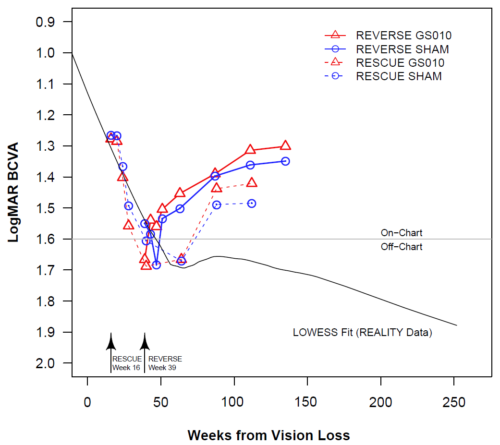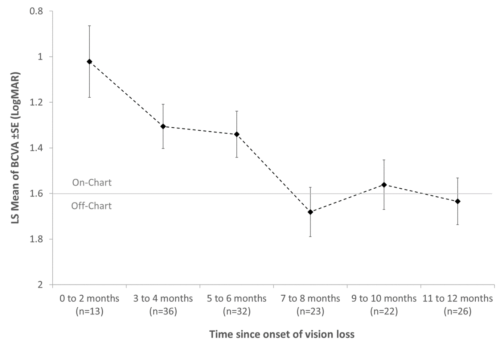Paris, France, Wednesday, December 11, 2019, 7.30 am CET – GenSight Biologics (Euronext: SIGHT, ISIN: FR0013183985, PEA-PME eligible), a biopharma company focused on discovering and developing innovative gene therapies for retinal neurodegenerative diseases and central nervous system disorders, today reported results from the REALITY registry study and an analysis of REVERSE and RESCUE Phase III data, which further highlight the poor prognosis for patients with loss of vision due to Leber Hereditary Optic Neuropathy (LHON) associated with the ND4 mutation. The results confirm LHON experts’ observations from their clinical practice and contrast sharply against the bilateral improvement observed in LUMEVOQ™ (GS010)’s Phase III studies.
“Natural history studies in LHON have been difficult to conduct, so these results add to the body of knowledge and firm up the conventional wisdom that with rare exceptions, LHON is marked by precipitous loss of vision with little chance of improvement in the first few years,” commented Mark Moster, MD, Neuro-Ophthalmology, Wills Eye Hospital and Professor of Neurology and Ophthalmology at Thomas Jefferson University, Philadelphia, United-States, and investigator in the REVERSE and RESCUE trials. “The lack of improvement in the REALITY subjects is in stark contrast to the improvements seen in our REVERSE and RESCUE patients.”
REALITY is a retrospective and cross-sectional observational study of subjects with LHON, conducted in centers across Spain, Italy, France, United Kingdom, and the United States. The objective is to generate insights about the natural history of the disease based on an approach that would facilitate comparisons with REVERSE and RESCUE. The study seeks to enroll 50 subjects by the second quarter of 2020.
Interim analysis of REALITY, based on the fifteen subjects with the ND4 mutation who were at least 15 years old at onset and who had enrolled in the study as of September 2019, shows the dramatic and usually irreversible decline in visual acuity that is the typical outcome for ND4 LHON patients. Unlike in subjects enrolled in REVERSE and RESCUE, who all received a unilateral injection of LUMEVOQ™, mean visual acuity in REALITY subjects did not recover after the initial decline.
Figure 1. LHON Natural History from Interim Analysis of REALITY vs. Time Course of Visual Acuity from REVERSE and RESCUE

Note: BCVA = best-corrected visual acuity. The LOWESS line for REALITY (n=15 subjects) is based on a series of polynomial regressions around each data point. The regressions use a limited look back and look forward and give distant points less weight. The time course of BCVA for REVERSE and RESCUE uses the least-squares mean based on a mixed model ANCOVA analysis. The starting points of the curves are set to the average time from onset to time of treatment (16 weeks for RESCUE, 39 weeks for REVERSE).
“These findings highlight just how remarkable the visual trends in REVERSE and RESCUE are,” commented Bernard Gilly, Co-founder and Chief Executive Officer of GenSight. “The findings will support our effort to provide regulatory authorities with the most robust insights about the natural history of the disease, so that we can convincingly demonstrate the therapeutic benefit delivered by LUMEVOQ™.”
A second set of results, derived from a pooled dataset of baseline readings from the REVERSE and RESCUE patient populations, shows that eyes farther along the progression of the disease, as measured by time since onset, had worse visual acuity.
Figure 2. Best-Corrected Visual Acuity (BCVA) Prior to Injection Among REVERSE and RESCUE Patients, by Time Since Onset

Note: Eyes of REVERSE and RESCUE patients were categorized according to the time between onset of vision loss and baseline reading (one day before injection). The n’s represent the number of eyes in each time grouping. By design, the maximum value for onset in the pooled data is 12 months. The average for each group represents the least-squares mean of BCVA values in LogMAR. The y-axis shows an inverted LogMAR scale to represent worse vision with lower vertical positions.
The picture of visual decline is based on cross-sectional data, yet remains consistent with the pattern revealed by the interim analysis for REALITY.
About GenSight Biologics
GenSight Biologics S.A. is a clinical-stage biopharma company focused on discovering and developing innovative gene therapies for retinal neurodegenerative diseases and central nervous system disorders. GenSight Biologics’ pipeline leverages two core technology platforms, the Mitochondrial Targeting Sequence (MTS) and optogenetics, to help preserve or restore vision in patients suffering from blinding retinal diseases. GenSight Biologics’ lead product candidate, GS010, is in Phase III trials in Leber Hereditary Optic Neuropathy (LHON), a rare mitochondrial disease that leads to irreversible blindness in teens and young adults. Using its gene therapy-based approach, GenSight Biologics’ product candidates are designed to be administered in a single treatment to each eye by intravitreal injection to offer patients a sustainable functional visual recovery.
About LUMEVOQ™ (GS010)
LUMEVOQ™ (GS010) targets Leber Hereditary Optic Neuropathy (LHON) by leveraging a mitochondrial targeting sequence (MTS) proprietary technology platform, arising from research conducted at the Institut de la Vision in Paris, which, when associated with the gene of interest, allows the platform to specifically address defects inside the mitochondria using an AAV vector (Adeno-Associated Virus). The gene of interest is transferred into the cell to be expressed and produces the functional protein, which will then be shuttled to the mitochondria through specific nucleotidic sequences in order to restore the missing or deficient mitochondrial function. “LUMEVOQ” was accepted as the invented name for GS010 (lenadogene nolparvovec) by the European Medicines Agency (EMA) in October 2018.
AbouT Leber Hereditary Optic Neuropathy (LHON)
Leber Hereditary Optic Neuropathy (LHON) is a rare maternally inherited mitochondrial genetic disease, characterized by the degeneration of retinal ganglion cells that results in brutal and irreversible vision loss that can lead to legal blindness, and mainly affects adolescents and young adults. LHON is associated with painless, sudden loss of central vision in the 1st eye, with the 2nd eye sequentially impaired. It is a symmetric disease with poor functional visual recovery. 97% of patients have bilateral involvement at less than one year of onset of vision loss, and in 25% of cases, vision loss occurs in both eyes simultaneously. The estimated incidence of LHON is approximately 1,400 to 1,500 new patients who lose their sight every year in the United States and Europe.
About RESCUE and REVERSE
RESCUE and REVERSE are two separate randomized, double-masked, sham-controlled Phase III trials designed to evaluate the efficacy of a single intravitreal injection of GS010 (rAAV2/2-ND4) in subjects affected by LHON due to the G11778A mutation in the mitochondrial ND4 gene.
The primary endpoint will measure the difference in efficacy of GS010 in treated eyes compared to sham-treated eyes based on Best‑Corrected Visual Acuity (BCVA), as measured with the ETDRS at 48 weeks post-injection. The patients’ LogMAR (Logarithm of the Minimal Angle of Resolution) scores, which are derived from the number of letters patients read on the ETDRS chart, will be used for statistical purposes. Both trials have been adequately powered to evaluate a clinically relevant difference of at least 15 ETDRS letters between treated and untreated eyes adjusted to baseline.
The secondary endpoints will involve the application of the primary analysis to best‑seeing eyes that received GS010 compared to those receiving sham, and to worse‑seeing eyes that received GS010 compared to those that received sham. Additionally, a categorical evaluation with a responder analysis will be evaluated, including the proportion of patients who maintain vision (< ETDRS 15L loss), the proportion of patients who gain 15 ETDRS letters from baseline and the proportion of patients with Snellen acuity of >20/200. Complementary vision metrics will include automated visual fields, optical coherence tomography, and color and contrast sensitivity, in addition to quality of life scales, bio‑dissemination and the time course of immune response. Readouts for these endpoints are at 48, 72 and 96 weeks after injection.
The trials are conducted in parallel, in 37 subjects for REVERSE and 39 subjects for RESCUE, in 7 centers across the United States, the UK, France, Germany and Italy. Week 96 results were reported in 2019 for both trials, after which patients were transferred to a long-term follow-up study that will last for three years.
ClinicalTrials.gov Identifiers:
REVERSE: NCT02652780
RESCUE: NCT02652767
About REFLECT
REFLECT is a multi-center, randomized, double-masked, placebo-controlled study to evaluate the safety and efficacy of bilateral injections of GS010 in subjects with LHON due to the NADH dehydrogenase 4 (ND4) mutation.
The trial planned to enroll 90 patients with vision loss up to 1 year in duration and will be conducted in multiple centers in Europe and in the US.
In the active arm, GS010 will be administered as a single intravitreal injection to both eyes of each subject. In the placebo arm, GS010 will be administered as a single intravitreal injection to the first affected eye, while the fellow eye will receive a placebo injection.
The primary endpoint for the REFLECT trial is the BCVA reported in LogMAR at 1.5-Year post-treatment in the second‑affected/not‑yet‑affected eye. The change from baseline in second‑affected/not‑yet‑affected eyes receiving GS010 and placebo will be the primary response of interest. The secondary efficacy endpoints include: BCVA reported in LogMAR at 2-Years post-treatment in the second‑affected/not‑yet‑affected eye compared to both placebo and the first‑affected eye receiving GS010, OCT and contrast sensitivity and quality of life scales. The first subject was treated in March 2018, and enrolment was completed in July 2019, ahead of schedule.
ClinicalTrials.gov Identifiers:
REFLECT: NCT03293524
About REALITY
REALITY is a multi-country retrospective and cross-sectional observational study of affected LHON subjects, based on subjects’ medical charts and the administration of surveys on Health-Related Quality of Life (HRQoL) and direct and indirect costs associated with the disease.
The study will recruit at least 50 subjects (both adult and pediatric) chiefly in the following countries: Spain, Italy, France, United Kingdom, and the United States.
The primary objectives for the REALITY study are: to describe the evolution of visual functional and structural changes and other associated symptoms in patients with LHON; understand the impact of LHON-related vision loss on the HRQoL; and understand the economic burden for patients and their families arising from direct and indirect costs associated with the disease. The secondary objective is to describe the relationship between genetic, lifestyle and/or environmental factors and the expression of the LHON phenotype.
The first subject was enrolled on 3 January 2018, and enrollment is targeted to be completed in early Q2 2020.
ClinicalTrials.gov Identifiers:
REALITY LHON Registry: NCT03295071